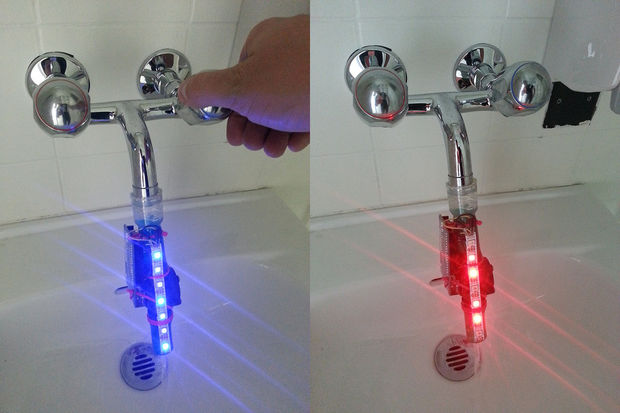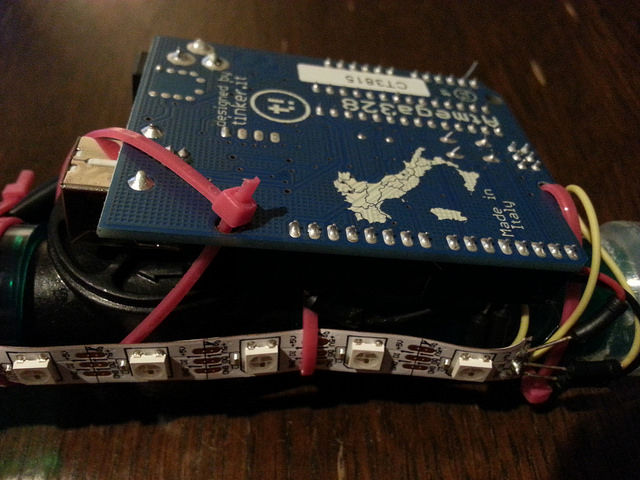Learn how to use inexpensive ILI9325 colour TFT LCD modules in chapter fifty of a series originally titled “Getting Started/Moving Forward with Arduino!” by John Boxall – A tutorial on the Arduino universe. The first chapter is here, the complete series is detailed here.
Introduction
Colour TFT LCD modules just keep getting cheaper, so in this tutorial we’ll show you how to get going with some of the most inexpensive modules we could find. The subject of our tutorial is a 2.8″ 240 x 320 TFT module with the ILI9325 LCD controller chip. If you look in ebay this example should appear pretty easily, here’s a photo of the front and back to help identify it:

There is also the line “HY-TFT240_262k HEYAODZ110510” printed on the back of the module. They should cost less than US$10 plus shipping. Build quality may not be job number one at the factory so order a few, however considering the cost of something similar from other retailers it’s cheap insurance. You’ll also want sixteen male to female jumper wires to connect the module to your Arduino.
Getting started
To make life easier we’ll use an Arduino library “UTFT” written for this and other LCD modules. It has been created by Henning Karlsen and can be downloaded from his website. If you can, send him a donation – this library is well worth it. Once you’ve downloaded and installed the UTFT library, the next step is to wire up the LCD for a test.
Run a jumper from the following LCD module pins to your Arduino Uno (or compatible):
- DB0 to DB7 > Arduino D0 to D7 respectively
- RD > 3.3 V
- RSET > A2
- CS > A3
- RW > A4
- RS > A5
- backlight 5V > 5V
- backlight GND > GND
Then upload the following sketch – Example 50.1. You should be presented with the following on your display:

If you’re curious, the LCD module and my Eleven board draws 225 mA of current. If that didn’t work for you, double-check the wiring against the list provided earlier. Now we’ll move forward and learn how to display text and graphics.
Sketch preparation
You will always need the following before void setup():
#include "UTFT.h"
UTFT myGLCD(ILI9325C,19,18,17,16); // for Arduino Uno
and in void setup():
myGLCD.InitLCD(orientation);
myGLCD.clrScr();
with the former command, change orientation to either LANDSCAPE to PORTRAIT depending on how you’ll view the screen. You may need further commands however these are specific to features that will be described below. The function .clrScr() will clear the screen.
Displaying Text
There are three different fonts available with the library. To use them add the following three lines before void setup():
extern uint8_t SmallFont[];
extern uint8_t BigFont[];
extern uint8_t SevenSegNumFont[];
When displaying text you’ll need to define the foreground and background colours with the following:
myGLCD.setColor(red, green, blue);
myGLCD.setBackColor(red, green, blue);
Where red, green and blue are values between zero and 255. So if you want white use 255,255,255 etc. For some named colours and their RGB values, click here. To select the required font, use one of the following:
myGLCD.setFont(SmallFont); // Allows 20 rows of 40 characters
myGLCD.setFont(BigFont); // Allows 15 rows of 20 characters
myGLCD.setFont(SevenSegNumFont); // allows display of 0 to 9 over four rows
Now to display the text use the function:
myGLCD.print("text to display",x, y);where text is what you’d like to display, x is the horizontal alignment (LEFT, CENTER, RIGHT) or position in pixels from the left-hand side of the screen and y is the starting point of the top-left of the text. For example, to start at the top-left of the display y would be zero. You can also display a string variable instead of text in inverted commas.
You can see all this in action with the following sketch – Example 50.2, which is demonstrated in the following video:
Furthremore, you can also specify the angle of display, which gives a simple way of displaying text on different slopes. Simply add the angle as an extra parameter at the end:
myGLCD.print("Hello, world", 20, 20, angle);Again, see the following sketch – Example 50.2a, and the results below:
Displaying Numbers
Although you can display numbers with the text functions explained previously, there are two functions specifically for displaying integers and floats.
You can see these functions in action with the following sketch – Example 50.3, with an example of the results below:

Displaying Graphics
There’s a few graphic functions that can be used to create required images. The first is:.
myGLCD.fillScr(red, green, blue);
which is used the fill the screen with a certain colour. The next simply draws a pixel at a specified x,y location:
myGLCD.drawPixel(x,y);
Remember that the top-left of the screen is 0,0. Moving on, to draw a single line, use:
myGLCD.drawLine(x1,0,x2,239);
where the line starts at x1,y1 and finishes at x2,y2. Need a rectangle? Use:
myGLCD.drawRect(x1,y2,x2,y2); // for open rectangles
myGLCD.fillRect(x1,y2,x2,y2); // for filled rectangles
where the top-left of the rectangle is x1,y1 and the bottom-right is x2, y2. You can also have rectangles with rounded corners, just use:
myGLCD.drawRoundRect(x1,y2,x2,y2); // for open rectangles
myGLCD.fillRoundRect(x1,y2,x2,y2); // for filled rectangles
instead. And finally, circles – which are quite easy. Just use:
myGLCD.drawCircle(x,y,r); // draws open circle
myGLCD.fillCircle(x,y,r); // draws a filled circle
where x,y are the coordinates for the centre of the circle, and r is the radius. For a quick demonstration of all the graphic functions mentioned so far, see Example 50.4 – and the following video:
Displaying bitmap images
If you already have an image in .gif, .jpg or .png format that’s less than 300 KB in size, this can be displayed on the LCD. To do so, the file needs to be converted to an array which is inserted into your sketch. Let’s work with a simple example to explain the process. Below is our example image:

Save the image of the puppy somewhere convenient, then visit this page. Select the downloaded file, and select the .c and Arduino radio buttons, then click “make file”. After a moment or two a new file will start downloading. When it arrives, open it with a text editor – you’ll see it contains a huge array and another #include statement – for example:

Past the #include statement and the array into your sketch above void setup(). After doing that, don’t be tempted to “autoformat” the sketch in the Arduino IDE. Now you can use the following function to display the bitmap on the LCD:
myGLCD.drawBitmap(x,y,width,height, name, scale);
Where x and y are the top-left coordinates of the image, width and height are the … width and height of the image, and name is the name of the array. Scale is optional – you can double the size of the image with this parameter. For example a value of two will double the size, three triples it – etc. The function uses simple interpolation to enlarge the image, and can be a clever way of displaying larger images without using extra memory. Finally, you can also display the bitmap on an angle – using:
myGLCD.drawBitmap(x,y,width,height, name, angle, cx, cy);
where angle is the angle of rotation and cx/cy are the coordinates for the rotational centre of the image.
The bitmap functions using the example image have been used in the following sketch – Example 50.5, with the results in the following video:
Unfortunately the camera doesn’t really do the screen justice, it looks much better with the naked eye.
What about the SD card socket and touch screen?
The SD socket didn’t work, and I won’t be working with the touch screen at this time.
Conclusion
So there you have it – an incredibly inexpensive and possibly useful LCD module. Thank you to Henning Karlsen for his useful library, and if you found it useful – send him a donation via his page.

In the meanwhile have fun and keep checking into tronixstuff.com. Why not follow things on twitter, Google+, subscribe for email updates or RSS using the links on the right-hand column? And join our friendly Google Group – dedicated to the projects and related items on this website. Sign up – it’s free, helpful to each other – and we can all learn something.
The post Tutorial – Arduino and ILI9325 colour TFT LCD modules appeared first on tronixstuff.















